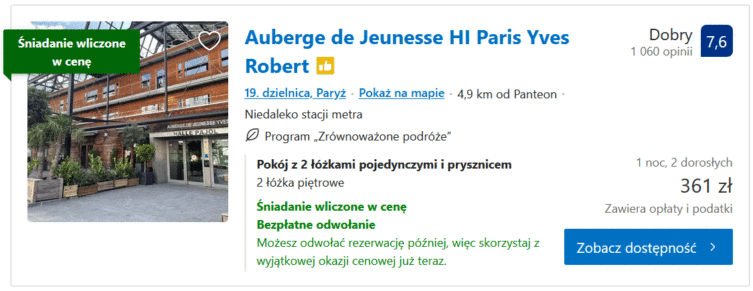Pantheon in Paris - sightseeing, tickets, interesting facts, buried people
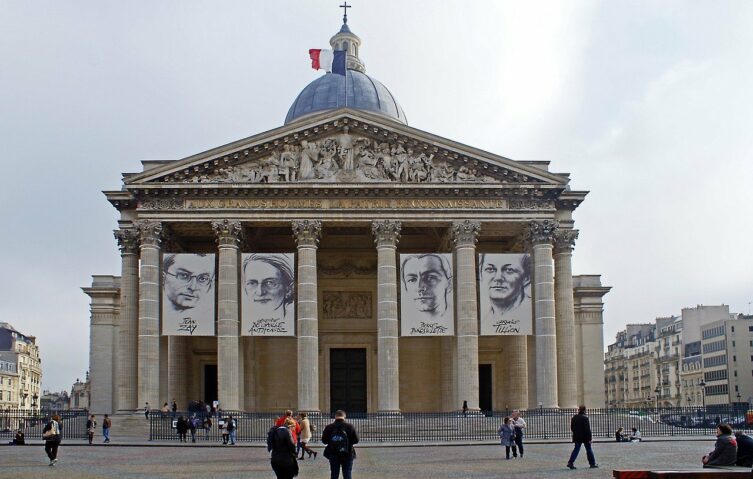
MrTheos
The pantheon is a combination of two Greek words: pan (all) + theos (god). The Pantheon, in short, was therefore a temple built to honor all gods. The most famous pantheon of the world is undoubtedly Pantheon in Rome. The one in Paris was created in his model and likeness, but ... it was not supposed to function as a pantheon.
Promise
The pantheon was built as a result of the promise made by the king of France, Louis XV. During his illness, he swore to the patron saint of Paris - Saint Geneveva - to build a temple in her honor, if he would be restored to health.
He healed. Just over 10 years later, the construction of the church began. It lasted over 30 years, and when it was about to end (only interior design remained) in 1789, the French Revolution broke out.
Temple of the nation
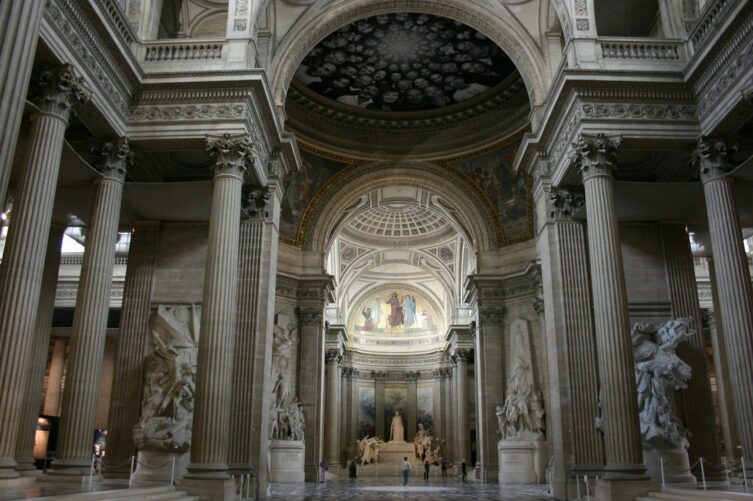
The revolution changed the world, including the later fate of the church. The idea arose in revolutionary circles to make the church a "temple of the nation". The National Legislative Assembly called the Kostituant, established by revolutionaries, decided:
"That this religious church may become the temple of the nation, that the tomb of a great man may become an altar of freedom."
A new inscription has appeared above the entrance:
"A grateful nation honors its great people"
The building has become the national mausoleum of France, where the ashes of the most prominent people are placed.
In the following years, attempts were made to restore its sacred functions, but ultimately it still plays the role assigned to it during the Revolution.
They were the first to be buried in the Pantheon Mirabeau and Voltaire.
The assembly of Voltaire's ashes was accompanied by an exhibition ceremony and crowds of people. The event was immortalized by Claude-Nicolas Malapeau in the painting "Transfer of Volaire to the Pantheon"
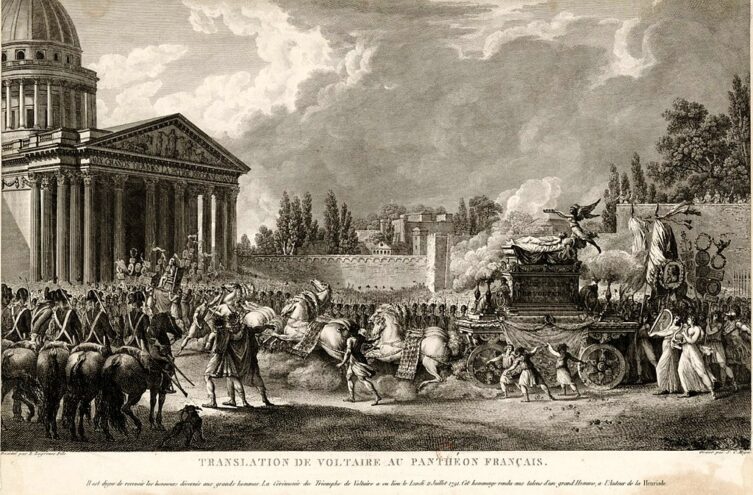
"Transfer of Volaire to the Pantheon"
Mirabeau's ashes were soon removed from the Pantheon, as he was considered an enemy of the revolution. Soon after this event, the government decided that only the ashes of people who had been dead for at least ten years could be placed in the Pantheon.
Polka in the Pantheon
The Pantheon is also a very important place for Poles, because ashes rest there Maria Skłodowskiej-Curie. In addition to our Nobel Prize winner, you will find here such names as Wolter, Wiktor Hugo, Jean-Jacques Rousseau, Emil Zola, and Aleksander Dumas.
According to data from December 2021, the ashes of 81 people (including only 6 women) are in the Pantheon. I attach the full list of people at the end of the post.
Little known secret of the Pantheon
When in October 2006 to the office of the director of the Pantheon Bernard Jeannot A man he didn't know walked in UX groups, Jeannot didn't know that his life had just changed.
The anonymous visitor introduced himself and told the director of the Pantheon a story which made Jeannot laugh, thinking it was a silly joke. So what did he hear?
Illegal workshop
About a year earlier, several members of the Paris secret UX groups (short for Urban eXplorers) dealing with the exploration of unknown corners of Paris, came up with the idea of repairing the decaying clock in the Pantheon. Regarded as a watchmaker's work of art, the 1850 Wagner clock (located above one of the passages) has been deteriorating for years, left to itself, and its hands have remained motionless for over 40 years.
The campaign started in November 2005. Members of the group simply entered the Pantheon as tourists, then hid and allowed themselves to be locked inside for the night. Then, under the dome of the Pantheon, they located a place that, in their opinion, was well suited for a workshop. Near the stairs leading to the future workshop, they found a side entrance door to the building that was perfectly placed for them, which turned out to be a trivial obstacle for a professional watchmaker. In the morning, there were no stray evening tourists in the Pantheon. The site for the workshop was selected and the passageway ready to handle the secret nightly activity of UX members.
As they themselves mention, the most difficult thing in the whole operation was ... secretly bringing in the boards from which the workshop equipment was made. Everything else turned out to be much easier. In the end, a very pleasant, illegal workshop was created under the dome of the Pantheon, which was more like a designer salon than a place to renovate an old clock. We even managed to connect electricity to the workshop and start the internet.
Renovation works on the clock, carried out secretly under the cover of night, lasted almost a year. The clock rejuvenated and came to life. It just needed to be wound up. The UX group held a heated debate on what to do next? Ultimately, they decided to notify the museum.
Disclosure and Consequences
An anonymous visitor told the director of the Pantheon this very story. No wonder Bernard Jeannot didn't believe it! To prove his story, the man from UX led the director up the stairs under the dome to the workshop. Here Jeannot experienced a real shock. He had to sit down and was silent for a long time.
The first reaction of the Pantheon administration to the situation was positive, but the rhetoric quickly changed. Bernard Jeannot had to leave his job, and the participants of the incident soon appeared before the French Court of Justice. They were accused of unlawfully trespassing and seizing a national monument, and of destroying a lock on one of the inner bars.
One lawyer claimed €48 in costs, but public prosecutor Anne Benejean said the accusation was "stupid" and she sought an acquittal herself. The judge, after deliberating for ten minutes, announced the verdict of acquittal.
Curiosity:
The administration of the museum in the Pantheon decided not to wind the clock, and it remained stationary. Therefore, the watchmaker of the UX group (Jean-Baptiste Viota) re-entered the Pantheon on December 24, 2006, repaired and put the bells connected to the clock into operation. Then he wound a clock which traditionally initiated the ringing of the bells on Christmas Eve, as long as it worked. The sonorous tolling of the bells from the Pantheon rose over Paris. This had its consequences.
One can get the impression that the indignant museologists made it a point of honor that the clock would not be wound.
If you decide to visit the Pantheon, look for the clock, look at it, remember this story and ... check if it shows the current time! You will get an answer to the question: have museum workers finally managed to accept the fact that the clock works?
Photos of the clock along with historical photographs from the hidden workshop and secret repair can be found at: urban-resources.net
Repairing the clock in the Pantheon is not the only achievement UX groups. They also have a lot in common parisian catacombs. By the way, the history of the catacombs is extremely entertaining and electrifying. You will learn more about this in a separate entry about Paris catacombs – [click]
Pantheon - entrance tickets
Luckily, the entrance ticket to the Pantheon can be purchased online. Below is a link to buy tickets,
Check it out: online admission tickets - Pantheon - [click]
The Pantheon is open daily from 10:00 to 18:00. Last visitors are admitted inside at 17:15.
Useful information
Pantheon, GPS coordinates:
48°50’47.2″N 2°20’42.5″E
48.846439, 2.345146 - click and route
Nearest metro stations:
Cardinal Lemoine - line number 10
Place Monge - line number 7
Worth seeing in the vicinity of the Pantheon
Just a few steps (literally 200 meters) from the Pantheon where Maria Skłodowska-Curie is buried, there is a building where she had her laboratory and conducted research. Currently, the building houses the Maria Skłodowska-Curie Museum with a very interesting exhibition and exhibits.
Laboratoruim - Maria Skłodowska-Curie Museum, GPS coordinates:
48°50’39.5″N 2°20’41.2″E
48.844307, 2.344769 - click and route
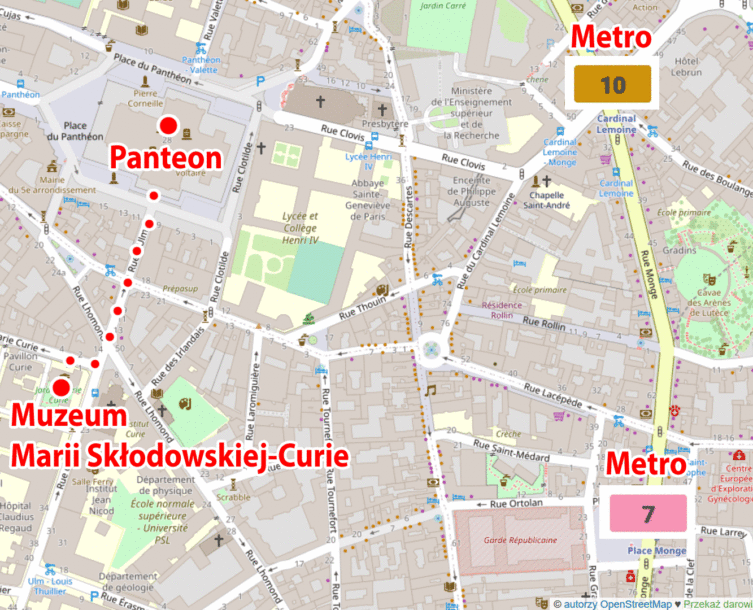
Paris sightseeing itinerary
This post is part of a very detailed itinerary for Paris that I have developed. The plan is available for free and you can see it on the website: Paris sightseeing plan - map, tickets, attractions, monuments, accommodation, interesting factsAccommodation in Paris
Below are links to some interesting accommodation in Paris. I tried to make them attractive in terms of price (for Paris) and to be as close as possible to the Pantheon. All of them (most importantly) are close to the metro station, which will allow you to get everywhere in no time.
The link has been prepared so that clicking on the proposed accommodation will take you to the details of the accommodation, but will also allow you to see other, similar offers. Therefore, it is worth treating the hotels I have selected as a starting point for my own research. Hotels often make temporary price cuts. So it is possible that by clicking on one of my offers, you will immediately find another, better-priced offer. It's worth clicking and looking.
Caulaincourt Montmartre by Hiphophostels - [click]
Hotel du Roussillon - [click]
Auberge de Jeunesse HI Paris Yves Robert - [click]
List of people buried in the Pantheon in Paris
Below you will find a detailed list of those buried in the Pantheon in Paris. The list is arranged chronologically according to the year in which the ashes were placed.
| in the Pantheon from | name | he lived in years |
|---|---|---|
| 1791 | Mirabeau | 1749-1791 |
| 1791 | Voltaire | 1694-1778 |
| 1792 | Nicolas-Joseph Beaurepaire | 1740-1792 |
| 1793 | Louis Michel le Peletier de Saint Fargeau | 1760-1793 |
| 1793 | Augustin-Marie Picot | 1756-1793 |
| 1794 | Jean-paul marat | 1743-1793 |
| 1794 | Jean-Jacques Rousseau | 1712 – 1778 Feet |
| 1806 | François Denis Tronchet | 1726-1806 |
| 1806 | Claude-Louis Petiet | 1749-1806 |
| 1807 | Jean-Étienne-Marie Portalis | 1746-1807 |
| 1807 | Louis-Pierre-Pantaleon Resnier | 1759-1807 |
| 1807 | Louis-Joseph-Charles-Amable d'Albert, duc de Luynes [fr] | 1748-1807 |
| 1807 | Jean-Baptiste-Pierre Bevière [fr] | 1723-1807 |
| 1808 | François Barthélemy, comte Beguinot [fr] | 1747-1808 |
| 1808 | Pierre Jean Georges Cabanis | 1757-1808 |
| 1808 | Gabriel-Louis, marquis de Caulaincourt [fr] | 1741-1808 |
| 1808 | Jean-Frederic Perregaux | 1744-1808 |
| 1808 | Antoine-César de Choiseul, duc de Praslin [fr] | 1756-1808 |
| 1808 | Jean-Pierre Firmin Malher | 1761-1808 |
| 1809 | Jean Baptiste Papin, comte de Saint-Christau [fr] | 1756-1809 |
| 1809 | Joseph-Marie Vienna | 1716-1809 |
| 1809 | Pierre Garnier de Laboissiere | 1755-1809 |
| 1809 | Jean Pierre, Comte Sers [fr] | 1746-1809 |
| 1809 | Jérôme-Louis-François-Joseph, comte de Durazzo [fr] | 1739-1809 |
| 1809 | Justin Bonaventure Morard de Galles | 1761-1809 |
| 1809 | Emmanuel Cretet de Champmol | 1747-1809 |
| 1810 | Cardinal Giovanni Battista Caprara | 1733-1810 |
| 1810 | Louis Charles Vincent Le Blond de Saint-Hilaire | 1766-1809 |
| 1810 | Jean-Baptiste Treilhard | 1742-1810 |
| 1810 | Jean Lannes de Montebello | 1769-1809 |
| 1810 | Charles Pierre Claret de Fleurieu | 1738-1810 |
| 1811 | Louis Antoine de Bougainville | 1729-1811 |
| 1811 | Cardinal Charles Erskine de Kellie | 1739-1811 |
| 1811 | Alexandre-Antoine Hureau de Sénarmont | 1769-1811 |
| 1811 | Cardinal Ippolito Antonio, Cardinal Vincenti Mareri [it] | 1738-1811 |
| 1811 | Nicolas Marie Songis des Courbons | 1761-1811 |
| 1811 | Michel Ordener, 1st Count Ordener [26] | 1755-1811 |
| 1812 | Jean Marie Pierre Dorsenne | 1773-1812 |
| 1812 | Jan Willem de Winter | 1761-1812 |
| 1813 | Hyacinthe-Hugues-Timoleon de Cossé, Comte de Brissac [fr] | 1746-1813 |
| 1813 | Jean-Ignace Jacqueminot, Comte de Ham [fr] | 1758-1813 |
| 1813 | Joseph-Louis Lagrange | 1736-1813 |
| 1813 | Jean Rousseau [fr] | 1738 – 1813 Feet |
| 1813 | Justin de Viry [fr] | 1737-1813 |
| 1814 | Frederic Henri Walther | 1761-1813 |
| 1814 | Jean-Nicolas Demeunier | 1751-1814 |
| 1814 | Jean-Louis-Ebenezer Reynier | 1771-1814 |
| 1814 | Claude Ambroise Regnier de Massa di Carrara | 1746-1814 |
| 1815 | Antoine-Jean-Marie Thévenard | 1733-1815 |
| 1815 | Claude-Juste-Alexandre Legrand | 1762-1815 |
| 1829 | Jacques-Germain Soufflot | 1713-1780 |
| 1885 | Victor Hugo | 1802-1885 |
| 1889 | Lazare Carnot | 1753-1823 |
| 1889 | Jean-Baptiste Baudin | 1811-1851 |
| 1889 | Théophile Corret de la Tour d'Auvergne | 1743-1800 |
| 1889 | François Severin Marceau | 1769-1796 |
| 1894 | Marie François Sadi Carnot | 1837-1894 |
| 1907 | Marcellin Berthelot | 1827-1907 |
| 1907 | Sophie Berthelot | 1837-1907 |
| 1908 | Émile Zola | 1840-1902 |
| 1920 | Leon Gambetta | 1838-1882 |
| 1924 | Jean Jaures | 1859-1914 |
| 1933 | Paul Painleve | 1863-1933 |
| 1948 | Paul Langevin | 1872-1946 |
| 1948 | Jean Perrin Nobel Laureate " | 1870-1942 |
| 1949 | Victor Schoelcher | 1804-1893 |
| 1949 | Marc Schoelcher | 1766-1832 |
| 1949 | Felix Eboué | 1884-1944 |
| 1952 | Louis Braille | 1809-1852 |
| 1964 | Jean Moulin | 1899-1943 |
| 1967 | Antoine de Saint-Exupéry | 1900-1944 |
| 1987 | René Cassin Nobel Laureate " | 1887-1976 |
| 1988 | Jean Monnet | 1888-1979 |
| 1989 | Abbé Henri Grégoire | 1750-1831 |
| 1989 | Gaspard monge | 1746-1818 |
| 1989 | Nicolas de Condorcet | 1743-1794 |
| 1995 | Pierre Curie Nobel Laureate (1903) " | 1859-1906 |
| 1995 | Marie Skłodowska Curie Nobel Laureate (1903 and 1911) " | 1867-1934 |
| 1996 | André Malraux | 1901-1976 |
| 1998 | Toussaint Louverture | 1743-1803 |
| 1998 | Louis Delgres | 1766-1802 |
| 2002 | Alexandre Dumas | 1802-1870 |
| 2011 | Aimé Césaire | 1913-2008 |
| 2015 | Jean Zay | 1904-1944 |
| 2015 | Pierre Brossolette | 1903-1944 |
| 2015 | Germaine Tillion | 1907-2008 |
| 2015 | Geneviève de Gaulle-Anthonioz | 1920-2002 |
| 2018 | Simone Veil | 1927-2017 |
| 2018 | Antoine Veil | 1926-2013 |
| 2020 | Maurice Genevoix | 1890-1980 |
| 2021 | Josephine baker | 1906-1975 |
Important to me!
Give the article a good rating (5 stars welcome 😀)!It's free, a for me it is very important! The blog lives on visits and thus has a chance to develop. Please do it and ... thank you in advance!
If you like my guides, you will certainly find the one I created useful guide catalog - [click]. There you will find ready-made ideas for your next trips, descriptions of other tourist destinations and an alphabetical list of guides divided into countries, cities, islands and geographical regions.
I also post link to Facebook profile - [click]. Come in and press "Follow"then you will not miss new, inspiring posts.
Unless you prefer Instagram. I'm not a social media demon, but you can always count on something nice to look at on my instagram profile - [click]. The profile will gladly accept any follower who likes it.
I make the content I create available free of charge with copyright, and the blog survives from advertising and affiliate cooperation. So, automatic ads will be displayed in the content of the articles, and some links are affiliate links. This has no effect on the final price of the service or product, but I may earn a commission for displaying ads or following certain links. I only recommend services and products that I find good and helpful. Since the beginning of the blog's existence, I have not published any sponsored article.
Some of the readers who found the information here very helpful, sometimes ask me how you can support the blog? I do not run fundraisers or support programs (type: patronite, zrzutka or "buy coffee"). The best way is to use links. It costs you nothing, and support for the blog is self-generating.
Pozdrawiam



